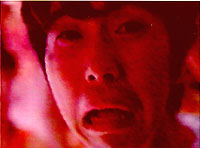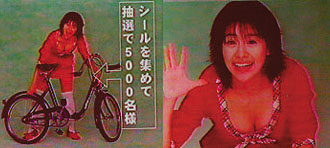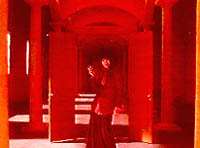-
Excerpt from coding sheet; Data source: Longitudinal Study of Japanese TV Commercials, 1992-1999
Maker: Sofina; Product: Foundation; Running Time: 15 seconds;
Recorded: Sunday, 10/3/99; 7:14 p.m. Show: Sanma no karakuri telebi
| SHOT |
ENCODED SIGN |
DECODABLE MEANING |
|---|
1. Medium-long, over shoulder
of actor 2 |
Female (F) enters bar alone |
F as independent;
Fits Iwao: current status |
| 2. Same |
Wearing clinging, shiny red dress |
Red = signifier of passion
Sexual excitation
See Appendix A |
| 3. Medium; from side |
Drum sounds like heartbeat;
F moves to bar |
Reinforces sexual motif;
emphasises social tension |
| 4. Tight: shoulders and face; angled slightly up over F's shoulder |
Male (M) behind bar. Youthful, fresh-scrubbed; wearing white |
White = signifier of purity; innocence; Note: Relative Size: M towers over F.
See Appendix B
|
| 5. Med-tight, angled up from behind bar |
F caressing drink |
Goffman 'feminine touch'
See Appendix C
|
| 6. Same |
F: Studied inattention |
Licensed withdrawal? Or waiting - open, available? |
| 7. Extreme tight on F's face; from side |
Suddenly raises eyes to meet M's; winks |
Women aware of social gaze;
Sexual aggressor;
Note: NO AVERTED GAZE
See Appendix D
|
| 8. Med; upward angle |
M frozen; registers shock |
Men as sexual followers |
| 9. Tight on glass |
M drops glass; it breaks |
Signifier for M's inner state: shock |
| 10. Quick shot, tight, angled on F's face |
Sound of glass shattering |
Signifier of impact; change in prior condition |
| 11. Same |
F's lips part just after glass breaks |
Desire; invitation to intimacy |
| 12. Med-tight, angled up of M's face |
Reaches out to touch F |
Male acting on invitation; overwhelmed by impulse.
See Appendix E
|
| 13. Extreme close-up |
F's hand meets M's |
Physical intimacy; F again as initiator |
| 14. Med.-close; angled slightly up |
F brings M's fingers to her face; F's eyes on M |
F in charge of her body; offers it to man.
See Appendix F
|
| 15. Tight on F's face; Same as Shot 7 |
Indirect look at camera; confidence, composure |
No shame or apology; suggests prior experience? |
| 16. F's face in compact; diagonal alongside product |
F regards herself in the mirror |
Fs tend to (be obsessed with?) view themselves;
(J. Berger here?) |
| 17. F and M, in compact. Again angled |
F turns to M and embraces him forcefully |
Physical intimacy; F again as initiator |
| 18. Tight on F, as in Shots 7 and 15; Her gaze on bar |
Appears disturbed. Brings hand to hair, drops it; parts her lips, closes them |
Emotion registered (overtly) by F; recognition of effect she's had on M |
| 19. Same shot |
Text superimposed, we hear M's voice: 'Is it okay to touch your skin?' |
F powerful; enchantress (see Buruma); M as desirous; in F's thrall
|
Coder's Comments: Good ad for paper on Gender. Multiple codes. Distills and underscores seminal recurrent themes embedded in many other Japanese ads:
(1) women as active, independent, sexually aggressive;
(2) men as passive, sexually naïve, desired;
(3) sexual relations defined in hetero terms;
(4) women presented as tactile;
(5) women depicted as observing themselves; watched by others;
(6) women tend to initiate intimacy
(7) intimacy expressed via physical contact;
(8) women portrayed as enchantresses; men as under their spell.
- - - - - - - - - - - - - - - - - - - - - - - - - - - - - - - - - - - - - - - - - - - - - - - - - - - - - - - - - - - - - - - - - - - - - -
The Theoretical Frame: Postmodernity, Ads, Gender
-
Just about everyone, it seems, has a name for the contemporary epoch. Most monikers are virtual clones, revolving around a common motif. So, although a writer might slip a 'middle' or 'late' in there, introduce a hyphen along the way, append an 'ism' or 'ity', or qualify it with a noun or adjective, most social analysts assert that we dwell in the postmodern era - a stage in capitalist development in which culture dominates;[1] in which 'the grand narrative'[2] has broken down in the face of a panoply of disparate voices, practices and forms.
-
The juxtaposition, degradation and expansion which characterises postmodernity has been assisted by a number of distinct, yet complementary factors: the globalisation of capital; the prevalence of electronic media such as television and internet as sources of entertainment, companionship, surveillance and knowledge; the proliferation of satellite technologies; the increased pace of social activity; the permeability of what, heretofore, have been relatively impenetrable cultural and language barriers; and the pell-mell explosion of popular culture into the fabric of everyday life. Finally, the simultaneous - though often contradictory - trends toward cultural expansion and ideational decomposition that have been stoked by the ascension of advertising provide one of the major vehicles of communication in contemporary society.[3]
The Importance of Advertising
-
Advertising's essential role in the degradation and expansion exposed by postmodern criticism inheres not so much from the relatively uniform - but ultimately impoverished - logic (of consumption) that forms its core;[4] nor from the variegated products it presents to viewers; nor from the array of styles in which it communicates. Nor is it only the speed at which ads reproduce the surrounding culture (although, this last factor, among the others, is certainly signal). Rather, advertising's import stems from the extensive amount of social content it encodes in its text. This secondary discourse[5] is what Barthes[6] long-ago identified as 'second-order signification' - the stuff of societal organisation, values and continuity. It is 'mythic' content that transports an ad reader far beyond the narrow, simplistic matters of product, purchase and use. In the cultural context I generally!
study (Japan), the conscious turn from consumption-oriented discourse in advertising toward 'product-least' or even 'product-less' discourse is a discernible, dramatic innovation with profound social repercussions.[7]
-
Perhaps this trend should not surprise us for, as Miller and Real assert, 'the more universalizing the grand narrative, the more postmodernity seeks to decenter its primacy.'[8] Thus is it that, in Japan, as part of the industry-wide trend to decenter the heretofore dominant theme of consumption, advertising has come to elevate discourse about other things: political values, body, national identity, emotion, technology, race and class, to name but a few.[9]
Gender as a Grand Narrative
-
One of the major areas of secondary discourse in advertising, of course, is gender. This has been recognised, at the very least, since Goffman's succinct,
|
compelling exposition, Gender Advertisements.[10] There he revealed a narrow, repetitive, systematic depiction of the sexes in (American magazine) advertising. Conspicuous in this regard was women's relative enfeebled status (in comparison to men) - in large part due to their objectified, overly feminised, insularised existence. When depicted together, men were more often portrayed as central, strong and dominant. In a word, Goffman demonstrated that a grand narrative pertaining to gender existed in American magazine advertising and, it could be inferred from its preponderance, that this phenomenon was reflective of a similar narrative coursing through American society, at large.
|
 Figure 1
Figure 1
|
About this paper
-
Assuming, as many do, a postmodern condition, the reasonable expectation would be that the grand narrative concerning gender would have come under assault in advertising. In certain societies that may be so. Yet, a study of Japanese television ads demonstrates that, at least as far as this particular medium in this particular cultural context goes, fraying of the unity in the gender narrative is far from the case. In this paper I would like to sort through the evidence, showing some of the ways in which the narrative relative to men and women does or does not hold together in TV advertising in the late 1990s. I do so, initially, by sticking rather closely to Goffman. Working with his term 'genderisms' (gender-specific behavioural styles) I show that what was true of American magazines and newspapers in the 1970s also applies to Japanese television in the 1990s - at least often enough to be worthy of note. Moreover, when such behavioural styles differ from those Goffman foun!
d, explanations can be located in culture or history to account for such discrepancy.
-
In short, at least insofar as TV ads are concerned, secondary discourse about social roles, sexuality, sexism, affection, emotion, intimacy, and personal character vis-à-vis men and women are presented in highly circumscribed, consistent, systematically different ways. And importantly, when these depictions deviate from those found by Goffman, they nonetheless differ from each other (i.e. are still gendered) in stereotypically patterned ways. In short, genderisms in Japanese television advertising tend to adhere closely to specific rules of presentation and engagement. Though neither absolute, nor etched completely in stone, it is difficult to discern significant deviation from or decomposition of the grand narrative concerning gender.
Gender Advertisements, Japan Inc.(arnation)
-
Goffman demonstrated that differences could be discerned between men and women depending upon a number of analytical categories, among them: relative size, ritualised subordination, functional ranking, licensed withdrawal, touch, and the family. As we see below, these categories apply to a considerable degree in Japanese ads.
|
Relative Size. Height is one way of demonstrating social weight - be it power, authority, rank, office, renown. While Goffman was careful to note that biology influences the perception of physical (i.e. size) difference between the sexes, 'picture posing rigorously completes' the sense of males as superior in stature. So, too, in Japanese TV. Often do we encounter men posed in ways that suggest they are larger (and therefore more powerful, important, central) than the women with whom they are grouped.
|
 Figure 2
Figure 2
 Figure 4
Figure 4
|
 Figure 3
Figure 3
 Figure 5
Figure 5
|
-
Ritualised Subordination. Of course, the placement of the woman beneath her husband, adjusting his tie as he heads off to work reveals a classic genderism: deference shown to a rank superior or dominant figure. Such poses are common in Japanese advertising. In the shots selected here, note how camera angle, geography and staging place the male in a superior physical position to the female with whom he is interacting.
 Figure 6
Figure 6
|
 Figure 7
Figure 7
|
 Figure 8
Figure 8
|
|
Functional Ranking. The depiction of man as a captain of a ship and woman as invited guest underscores the notion that, according to Goffman, in face to face encounters the man often performs the executive role. A large number of ads depict men as taking charge, as expert when women are in the picture.
|
 Figure 9
Figure 9
|
 Figure 10
Figure 10
|
This can be anything from exerting dominion over nature, styling a woman's hair, explaining the ABCs of tooth decay, demonstrating how to cook mushrooms to a supermarket full of female shoppers, or finding a restaurant in poorly-lit back streets.
 Figure 11a
Figure 11a
|
 Figure 11b
Figure 11b
|
-
Licensed Withdrawal. Men taking the lead often works to remove women from the situation. Goffman saw this as a psychological, no less than physical phenomenon. He concluded that emotional concealment and the physical dependence on others were hallmarks of this response. While dependence appears to thread itself through male/female interactions in Japanese ads, emotional concealment - at least on the part of woman - does not. I will have more to say about this below. And certainly, it has long been considered a sign of gentility in Japan to conceal emotions (for women to cover their mouths when laughing, for both sexes to transform their face into a mask so as not to betray inner feelings). Nonetheless, contemporary advertising offers us very few such examples. Instead, emotion is more often placed on public display. One of the major indicators of withdrawal that Goffman emphasised was the woman's averted gaze. This, too, is absent in Japanese ads. In its stead, direct!
address - to both the camera and fellow actors in the ad - predominates.
 Figure 12
Figure 12
|
 Figure 13
Figure 13
|
-
Feminine Touch. One of Goffman's more interesting findings was that women, more than men, were depicted using their hands. This is certainly true in Japan. And just as in Goffman's sample, Japanese ads emphasise touch unrelated to the narrow, utilitarian uses of a product. Thus, the camera captures women engaging in auto-exploration, adjusting baubles and clothes, and caressing loved ones. Women are often depicted caressing others: lovers, an unrelated child's hair, an unknown woman's hands, a female dancing partner. In a recent ad for Haagen-Dasz, the fingers of one woman are brought into contact with the mouth of another. A new candy is advertising its difference by showing women in their late teens repeatedly kissing one another on the cheeks.
 Figure 14
Figure 14
|
 Figure 15
Figure 15
|
 Figure 16
Figure 16
|
 Figure 17
Figure 17
|
 Figure 18
Figure 18
|
 Figure 19
Figure 19
|
-
By contrast, there are virtually no situations in which men are so depicted. Hands are mere instruments by which men wield products. Occasionally they hold a partner's hand or engage in an unrelated activity like fishing, computing or baseball. Nonetheless, it is seldom, if ever, that male hands are partialed, and highlighted by the camera. Taken together - the presence of female touch and the absence of male touch - underscores the notion that women are more expressive with their hands and certainly more tactile. Their physical boundaries, in terms of physical and emotional space, are far less constrained than those of men. Importantly, much of their tactile expression is directed toward those of the same sex - a point we will revisit a bit further on.
-
The Family: Physical contact often transpires within the family. And, as in America, the family is a commonly depicted social group. Goffman found that when families appear, unity is a key motif: engaging in a shared act. At the same time, he also found that within the unit, special relationships appeared to exist between same sexed parents and children. This appears to be the case in Japan, as well. Just as in Goffman's study, Japanese ads commonly picture the man outside of the frame - either as absent or at a certain distance.
 Figure 20
Figure 20
|
 Figure 21
Figure 21
|
 Figure 22
Figure 22
|
 Figure 23
Figure 23
|
-
Goffman suggested that distance signalled a particular function: the male's role of surveillance and protection. In Japan, however, this could just as easily reflect the common belief that the father has little place in the home. The reality of contemporary Japanese families - with a father often working long hours or else stationed in another city altogether - lends a certain harsh realism to gendered depictions of the family (and, conversely, makes a mockery of representations which posit an active, engaged father). In fact, ads often work to exploit the reality of spatial distance. A recent ad, played in comedic-operetta form, presents a husband frantically calling his wife from his apartment in another city, complaining that he doesn't have a clean shirt for the important meeting the next day. A son calls from college to inform her he has no rice to cook for his next meal. What's a mother to do? Since it's up to her to keep the family ship afloat, she calls up the deliv!
ery service and sends a shirt one way, a bag of rice the other.
|
Gender Roles/by Domain. This last discussion raises the point that differentiation often occurs via social role. Goffman observed that in ads inside the home, men are often depicted doing very little. He speculated that this might be because the home is the traditional 'female domain' and, thus, to raise a finger in that space would transform the man into a subordinate; in the alternative, he might become contaminated by the 'female task'.
|

Figure 24
|
 Figure 25
Figure 25
|
 Figure 26
Figure 26
|
 Figure 27
Figure 27
|
-
While Japanese ads tend to emphasise women as home-makers, a large number of ads show women performing in outside occupations. In this way ads mirror the social reality 'out there' - i.e. a considerable proportion of the workforce is female. By the same token, while ads clearly communicate that a man's place is outside - often engaged in active, physically-demanding pursuits - they also suggest that men are capable of helping in the kitchen.[11]
-
When it comes to the question of who is 'expert' in the home, the conclusion is actually mixed. Many ads present the woman as the authority when it comes to cooking, cleaning and shopping; others, depict the woman as receiving sage tips from a male narrator, partner or invited guest. Overall, though, the gendering of domains (i.e. women at home, men in the outer world of work) is still a very common stereotype. One ludicrous representation is found in an ad for instant noodles. The fatigued salary-man trudges up the pathway to his sprawling American-style home, only to be met by his vivacious, spinning, singing wife, who offers him two instant dinner choices.
 Figure 28a
Figure 28a
|
 Figure 28b
Figure 28b
|
 Figure 28c
Figure 28c
|
A more commonplace depiction is found in a stew ad. The man, finishing up in the field sings out: '(Food) ready yet?' which is met by the reply from his wife toiling in the kitchen: 'Not yet.' He calls out again, met by her return, and so on, back and forth, until he has arrived at her windowsill, at which point she informs him it is time to eat.
Behavioural (Stereo) types
-
Goffman's argument was qualitative more than quantitative. He was interested, above all, in suggesting a number of ways men and women were presented in American ads. A major point he made was that depicted behaviours often revealed underlying stereotypes held by society about gender. In the same way, Japanese ads are equally telling, though (as we will see below) in many other ways than those suggested by Goffman. Nonetheless, stereotypes consistently emerge in ad text and, importantly, these stereotypes are: (a) consistent within gender designations, and (b) differential between gender groupings. One way to see this is by studying ad campaigns that seek to sell the same product in separate ads featuring, respectively, male and female actors. Consider the following example, reproduced in simplified coded form.
Maker: Sapporo; Product: Brau (beer); Running Time: 15 seconds;
Recorded: Thursday, 11/19/98; 9:26 p.m. Show: Dochi no ryori Show
| FRAME |
MALE VERSION |
FEMALE VERSION |
|---|
| 1. |
Tight shot on product being poured into glass |
Identical shot |
| 1. |
Sound of beer filling glass; BGM: Beatles: 'All you Need is Love' |
Identical |
| 2. |
Establishing shot: medium long; from side: M drinking beer in another room |
Establishing shot: tight on face, at angle: F drinking beer |
| 3. |
Extreme Tight: on M's throat/chin |
Extreme tight on F's eyes: they widen, move to the side suggesting mental activity |
| 3. |
Sound: ravenous gulping |
Sound: soft gulping |
| 4. |
Med-tight from side: M drinking |
Med-tight: F regarding glass;
Superimposed: 'Really!' |
| 5. |
Extreme tight: M's throat; superimposed: 'Really!' |
Medium-tight, angled: F exhales, looks satisfied |
| 6. |
Medium-tight, from side: M exhales, satisfied. |
Medium, from side, behind: F regards product, looks out window |
| 7. |
Tight on product: hand places empty glass beside it. |
Identical shot. |
| 8. |
Med-tight from side: M holds product, looks into space. Superimposed script with his voiceover: '(You) can taste it; it has taste!' |
Med-tight from side. F holds product, talks into a phone. Superimposed script: identical. Her VO: identical.
|
In ads such as this - where direct comparison is available - it becomes clear that advertisers (and, by extrapolation, society at large), view men and women as different beings.
-
Men are physical, women emotional. For one, men are rougher - as evidenced by the focus on the throat and the loud, voracious drinking.[12] Women, by contrast, are sensitive internalisers. Their thoughts and feelings are registered with the eyes.
Men are loners, women are social. Consistently, Japanese ads tell us that men are alone, either socially isolated by lack of skill or personal preference. Thus, they tend to experience the world in isolation - in contrast to women who, even if their initial experience transpires alone, will quickly share it with someone else.[13] In the above ad this is symbolised by the tag phrase being spoken by the female protagonist over the phone.
Male Version
 Figure 29
Figure 29
|
Female Version
 Figure 30
Figure 30
|
-
Men are stylish, women are sexy. In a recent campaign for 'skin-water' (a moistening lotion), a woman removed her clothes outdoors (became natural in nature) and applied the product behind the thin veil of a back-lit white sheet; a man, by contrast, applied his version of the product inside the dark, private confines of his home, adorned in boxer shorts, western boots and cowboy hat. The ads clearly communicated differing perceptions of the protagonists. Though each ad partialed the two bodies, the female version emphasised the woman's objective status - her body as a sexual instrument. This was underscored in the final sequence when the sheet, rippled by the breeze, threatened to expose her genitals and forced her to desperately clutch at and struggle with the sheet. The male version, by contrast, de-emphasised bodily exposure in favour of playing up his: style, rugged application of the product and overall attitude.
Presentational Themes
-
The previous comparison reveals one of the central areas of difference between men and women in ads: sexuality. In turn, this genderism delivers us into the realms of status and character, broaching - most significantly - matters of social change and - less importantly, but interestingly - communication techniques that work to service the perpetuation of certain genderisms. Before concluding, I will consider each of these components.
Sexuality
-
Advertising in Japan is a competition for audience attention in a very narrow, noisy, overcrowded audio-visual environment. One of the ways advertisers have sought to gain viewer recognition is by invoking the shock of the new. This means that ads are made as contemporary, as hip and plugged into popular culture as possible. It also means that ever more extreme acts and images are piled one atop another - the electronic equivalent of an addict's need for increasing doses. The most extreme images generally revolve around sexual acts, sexual presentations of individuals and humans in interaction. Increasingly, they also comprise a considerable quantitative portion of ad space.
 Figure 31a
Figure 31a
|
 Figure 31b
Figure 31b
|
|
The Hetero Impulse. According to Japanese ads the basic sexual dynamic centres on an interaction between the opposite sexes. In this way, ads betray the homophobic, hetero-fixation of dominant society. Repeated again and again, ad content works to replicate, even reify, the notion of heterosexuality as natural and desired because it is the only game in town.
|

Figure 32
|
 Figure 33
Figure 33
|
 Figure 34
Figure 34
|
 Figure 35
Figure 35
|
-
This is not to say that there is no intimacy between same-sexed folk, but as I explained above, such relationships are generally reserved for women who engage in acts of mothering, nurturing, companionship and non-sexual caressing.
 Figure 36
Figure 36
|
 Figure 37
Figure 37
|
 Figure 38
Figure 38
|
In the case of men, physical intimacy is rarely expressed toward other men, save for cases of contact during competition, under extenuating circumstances such as physical tests in nature, or else in the course of effecting the father-son bond. The rare times ads depict men touching affectionately is when foreigners interact. This is consistent with the general tendency in Japanese advertising to present foreigners as more extreme - be it in terms of physique, exposure of skin, achievement, or emotional expression.[14] Foreigners aside, though, the rule of thumb regarding sexuality by gender is of the long-standing, socially-sanctioned status-quo.
 Figure 39a
Figure 39a
|
 Figure 39b
Figure 39b
|
-
Out of the Closet: intimate contact. One area of considerable change, though, has been the depiction of sexuality. Japan has long been considered a bastion of decorum and restraint. Traditionally, public behaviour has been modest, with true feelings masked.[15] If expressed at all, one's desires and motives were often communicated indirectly, often non-verbally. For this reason, expressions of affection between the sexes (if any) tended to be via symbolic gesture or implication. In contemporary advertising much of this subtlety has fallen by the wayside. In particular, the kiss - long reserved for foreigners - is now being explored by Japanese couples, as is hand-holding.
 Figure 40
Figure 40
|
 Figure 41
Figure 41
|
 Figure 42
Figure 42
|
-
Other ads introduce contact between the sexes under non-sexual guises. For instance, when one salary-man tells his junior that 'this summer's Cup Noodles are stimulating!' the younger man is transported to a swimming pool where he is fondled, kissed and otherwise drowned in a sea of writhing bikini-clad women. When he asks his senior if it is 'this stimulating?' the older man shakes his head in discomfort and utters 'Not like that'. A series of quick cuts reveals his inner world is populated by professional wrestlers - all female - who pummel, abuse and dominate him.
 Figure 43
Figure 43
|
 Figure 44
Figure 44
|
 Figure 45
Figure 45
|
-
Similarly, another ad, posits two young men working security at a concert. The crowd presses forward, straining their linked hands to the breaking point. The two struggle to keep their hands locked, but, instead of clutching each others' fingers, inadvertently latch onto the breasts of a female fan. The woman first looks at one man, then the other, registering little in the way of anger or retribution. Aware that their touching has not fazed the woman, the two men turn to the camera and make a child's face of disgust.
 Figure 46a
Figure 46a
|
 Figure 46b
Figure 46b
|
 Figure 46c
Figure 46c
|
-
Women as aggressors, men as innocents. What should be clear in these depictions is that men do not intend to have contact with women. Physical intimacy comes their way. This image of the aggressive female and shy, reluctant male is reproduced continually in Japanese advertising.
 Figure 47
Figure 47
|
 Figure 48
Figure 48
|
 Figure 48
Figure 48
|
 Figure 50
Figure 50
|
-
One of the watersheds regarding ad sexuality occurred early in the decade when a woman demanded 'chyuu shite' [kiss me] of her male partner. Though they were alone on a balcony, the male shrank from her encroaching lips, unnerved by the woman's boldness. Today, as we saw above, it is the woman who is constructed as taking the lead in suggesting assignations. Consider the following two ads, one for shampoo, the other for whiskey.
Mild + Coat (1997):
'Kon ya' [tonight] the pert career woman chirps to her strapping partner, 'ne'? [okay?] she lightly touches the tip of his nose as the elevator doors close, sending them on their separate ways. His eyes register shock at the public display. The doors stifle his reply. The woman confidently strides away as the film fades to black.
Cut to a close-up of a metal door knob attached to frosted glass. The door opens revealing the same woman with a towel wrapped around her frame, barely covering the tops of her breasts. She is beaming, giddy with enthusiasm. 'I'm coming in!' she declares. Her partner, naked and lathering his head with shampoo, is startled. He turns his back in a defensive posture. Cut to a shot of the towel dropping to his lover's feet. During the shower she lathers his head and they end up frolicking and giggling under the water.
Cut to a final shot of the lovers, now clothed in their living room. The man snuggles the woman from behind, smelling her hair, sighing. His voiceover utters: 'Pretty.' She quickly rotates 180 degrees, turning into his embrace.[16]
Suntory Whiskey (1993):
A man and woman in their early thirties sit at a table sipping whiskey. The woman leans toward her partner and in a suggestive voice utters: 'Hey, let's turn in soon.' The man protests, pointing to the drink: 'We haven't finished this, yet.' The woman inclines her head, quizzically. She speaks more insistently: 'Let's head home.' Then in a conspiratorial undertone 'It's that day.' Then she winks. The man's elbow slips off the tabletop. The woman blows him a kiss. Cut to a cat hiding beneath one of its paws in embarrassment.
-
And this genderism is played out without end. One of the baldest recent examples is of a salary-man stopped dead in his tracks at a train station by his hard-churning, sex-charged partner - a heavy-set middle-aged woman who blares his name out, vaults into his outstretched arms, and wraps her legs around his waist. Such climbing behavior appears infectious: a second ad presents us with a woman who wakes up in the morning and scales the back of her partner who's innocently brushing his teeth.
-
Men as Desired Subject. Such ads - and there are a slew of others - underscore the notion that women desire, men are desired. As I have shown elsewhere,[17] this pattern begins early - with recent ads depicting junior high and high school women pining for young men. As we have seen on these pages, the range of women pursuing men cuts across age and class lines. It is as present in the case of a twenty-something year-old women entering a bar as it is for a fifty-something year-old woman staring across a hot spring with her husband.
 Figure 51
Figure 51
|
 Figure 52
Figure 52
|
 Figure 53
Figure 53
|
-
And the image that emerges from ads is not only of men who are desired, but men who are watched. Berger has argued that in western art 'men act and women appear. Men look at women. Women watch themselves being looked at.'[18] In Japanese ads, this is true to some degree - men are active out in the world; they also do notice women. However, increasingly, it seems, it is the women who act and the men who get noticed.[19] In some ways, this reverses the traditional pattern, with women becoming the active doers and men being transformed into the subjects of human gaze, the objects of vision, the spectacle, the sight.
-
From many, two recent examples stand out. It is from this nascent, unfolding dimension of contemporary advertising that this paper's title is derived. The first is a whiskey ad featuring, Kimura Takuya, arguably Japan's most popular male talent. In this ad, Kimutaku (as he is affectionately called) sits alone on the edge of a bed in a seedy-looking hotel room. Near the ceiling is a television screen on which a scene of a dancing woman is playing. She is gyrating to the original song, I'm Your Venus. Cut to Kimutaku holding a fire-extinguisher-sized soda canister where his erection might be. The canister emits a thick jet of foamy water. Subsequent versions of the ad have been issued, but in each the highlight is Kimutaku's sexual pantomime.
-
A second ad is part of a series for canned coffee in which a provocatively dressed 'talento', Iijama Naoko, sits in an isolated space reminiscent of the zoo on planet Tralfamadore to which Montana Wildhack was confined in Kurt Vonnegut's Slaughterhouse-Five. From this vantage point she spies on men struggling with one occupation or another. In a recent installment, she observed a muscular, grimy mechanic working on a car engine.
'Hey!' her voiceover coos. 'Work AGAIN?... Let's play!' Cut to tight shot of her pursed lips. 'Hey!... Let's go for a drive,' accompanying consecutive shots of the mechanic wiping sweat from his brow and the vamp's derriere. Finally, in frustration she sighs: 'Oh, cars are cuter, huh?' The mechanic pauses to consider. Walks over to the product, pops the top. 'When it comes to that sort of man...' her VO says as he gulps the drink, 'women are suckers.' A final tight shot on her face. '[You're a] rake,' she pouts.
 Figure 54a
Figure 54a
|
 Figure 54b
Figure 54b
|
 Figure 54c
Figure 54c
|
In commercials such as these, then, it can be seen that the grand narrative (at least as defined in the American context years ago and mimicked in Japan for decades) is evincing signs of change.
Sexism
-
Reading the preceding it might be tempting to conclude that Japanese advertising is a woman's world where men are impotent wimps, at the mercy of powerful women. In fact, no matter how males are depicted, women have their own image problems. For Japanese ads work to undercut women at every turn by emphasising their sexuality and, in particular, by continually divesting them of clothing, thereby transforming them into objects for the social gaze. This is generally achieved by denying them volition or voice. Consider a few standard techniques.
-
Visual representation. Beyond the standard depictions of women as objects open for public scrutiny, in a number of cases objectification is achieved by actually transforming women into cardboard cut-outs or statues. The latter two examples are particularly disturbing insofar as the figures are made to serve the men who wield them. Further, one cut-out is literally 'bound' by metres of garden hose.
 Figure 55
Figure 55
|
 Figure 56
Figure 56
|
-
Partialing. A second way ad text transforms women into objects is by carving the models into distinct, disembodied parts. This is an ubiquitous approach, with favoured 'pieces' being the eyes, lips, breasts, bottoms, legs and necks. Not all of the partialing may reflect an intentional objectification agenda. As noted above, eyes are often used as a vehicle to capture expression - a genderism associated with women. Similarly, necks have long played a role (albeit pertaining to sensuality) in traditional Japanese culture.
 Figure 57
Figure 57
|
 Figure 58
Figure 58
|
 Figure 59
Figure 59
|
 Figure 60
Figure 60
|
 Figure 61
Figure 61
|
 Figure 62
Figure 62
|
-
Taken together, then, This treatment tends to reinforce the prevailing notion that women are objects, that their bodies come in distinct and severable parts for presentation and evaluation. Such a view is reinforced by ads such as a recent one for LLAOX, a discount appliance store. There a narrator shares photos of the many items he found. In a final shot, he presents an attractive woman preening for the camera. His voiceover proudly boasts: 'I found her at LLAOX, too!'
-
|
Bodies as sexual props. Of course, it is not just partialing that is at work in Japanese ads; rather it is the emphasis of woman's sexual parts. This is conveyed not only in the inordinate number of 'bust shots' when women are in the frame, but also the ever-increasing amount of exposed female skin.
|
 Figure 63
Figure 63
|
 Figure 64
Figure 64
|
 Figure 65
Figure 65
|
 Figure 66
Figure 66
|
-
Beyond the overt exposure, ad text works (both orally and visually) to make furtive reference to woman as sexual prop. Consider a recent campaign for a car named 'Rosso' ('red' in Italian, 'aka' in Japanese). The ad depicts a model (named 'Anna'), whose skin, hair and clothing have been tinted red. As noted at the outset, red is often used to signify passion and/or sexuality - certainly this is the case in Japanese ads. In this particular ad the sexual reading is unavoidable given the following: Anna's red mini-skirt, the multiple shots 'displaying' her vamping in front of the red car, and, finally, the lifting of her skirt. How her skirt comes to be raised is, itself, interesting. It seems that the view from behind is sufficiently provocative to cause the blood of a male on-looker to boil, thereby sending a cloud of steam to gush forth from his ears. The force of this flow, in turn, is sufficient to blow Anna's skirt upward, which, in turn!
, induces the witness to turn completely red. In a reaction shot he enthusiastically blurts out 'Rosso'. To which Anna responds by coyly pressing a finger against her lips - as if to say: 'Quiet - our little secret.'
 Figure 67
Figure 67
|
-
One interpretation of the 'Rosso' exclamation is confirmation of the colour of Anna's underclothing. If this appears an interpretative stretch, consider that in a contemporaneous (Japanese) ad for a rival car, Suzuki Move, Leonardo DiCaprio drove past two women with enough force to raise their skirts. DiCaprio abruptly braked, sent the car in reverse, rolled down his window, and pointed at the stunned women, in turn, informing them of colours ('white, strawberry') invisible to the naked eye.
Discussion: W(h)ither the Grand Narrative?
-
Behind this paper's analysis is recognition that genderisms in Japan are not identical with those found in America by Goffman. Certainly, this should come as no surprise. After one hundred years of formalised social science, the general consensus is that grand narratives 'vary from society to society and between different groupings and divisions - class, age, gender, urban/rural, etc - within societies.'[20] This is certainly true in the case of gender. We would expect genderisms to manifest themselves differently between, as well as within, societies due to contextual factors such as history, values, practices and demographics. Thus is it that the words 'woman', 'man' and, importantly, the meaning that emerges in their intercourse, will differ between countries like America and Japan.
-
To pick but one example, consider that Japan, unlike America, is often asserted to have been matriarchal - either in origin, earliest gestation or even up through the fourteenth century.[21] However, successive developments - including the embrace of Confucianism (with its strong patriarchal emphasis), the rise of a samurai class (where power was wielded through the alliance of households through marriage) the wider-spread practice of arranged marriages (to preserve the martial order) during the Edo period, and finally, with the (legal) consecration of the ie [household] system during the Meiji period, women saw their freedom, relative equality, and considerable power systematically stripped away.[22]
-
Again, quite different than in America (and many European nations), the notion that women are powerful - even supernatural - is a belief rooted in Asian culture, in general, and Japanese mythology, in particular. And unlike myths in the west (for instance, Greece), the Japanese sun deity is female, rather than male. She was formed, along with the Japanese archipelago, within the womb of Izanami. What emerges is a view of women as sacred and potent; a notion deeply ingrained in Japanese culture - as it is in Asian culture at large, as we will see a bit further below. Present, as well, though, is something less common in other Asian contexts - the idea that powerful women are demonic and, hence, to be dispatched in gruesome ways.
-
This representation of women as demonic and/or a threat requiring harsh treatment is widespread in Japanese cultural products.[23] Should it come as little surprise, then, that time and again advertising depicts women as aggressive, potent, supernatural, mysterious, self-centred, devilish, devious and dangerous? In the contemporary pool, one has little trouble locating ads in which women are viewed as active, filling positions of authority in the world of work, and self-absorbed. Consider, for instance, a recent ad in which a young (female) executive expends so much effort lavishing make-up on her face that she delays a board meeting. Disgruntled members' wait, then gawk in shock as the woman buzzes their glass-panelled boardroom in her private helicopter - all the while giggling mischievously.[24]
-
More positively, it is now commonplace for women to be depicted as assertive, assuming the lead over their reticent, sluggish male counterparts. This is especially true in the case of ads for new products.[25] While western analysts are wont to allege that advertising portrays women as subordinate[26] and passive,[27] in my study of political 'myths' in American ads[28] I encountered considerable representations of female liberation, though generally expressed in terms of sexuality. On the Japanese side of the equation, women have more recently been presented as autonomous, wilful and deliberative, although, again, often with a consistent backbeat of sexuality. At the same time, not all commercial portraits operate in such a strong, singular voice. Reflecting the polyphony of society at large, contemporary ads offer a powerful counter-current th!
at borrows from and/or is reinforced by the pop-idol-industry. Here, it is the image of women as cute, cuddly, vapid dolls - what are called 'kawaiiko-chan' - that is prominently reproduced. In short, then, there are contending images of women in Japanese ads - including the demonic, the assertive and the doll.
|
This notion of contradictory images regarding gender brings me, finally, to the case of 'Izam'.[29] A short two years ago, this rock singer caused a sensation by dyeing his elbow-length hair pink, painting his fingernails purple, glossing his lips plum, and donning flowing pleated skirts. Fashion was never the same, as teens (both male and female) took to following suit. Androgyny was suddenly hip. Ads immediately exploited this development, employing Izam as a signifier for change.
|
 Figure 68
Figure 68
|
'O-saki ni,' ('I'll go first') Izam addresses the camera. Heading against the flow, he quaffs a canned coffee and heads toward an open door. Beyond it: uncluttered blue skies.
The doors are centred along a narrow, bounded corridor, framed by Doric columns. Shot from above we note that they are set askew, all open. Interspersed are background images shot alternately at high speed and stop action. The result is a blur of conventional folk-businessmen and women moving in the opposite direction. The effect is surreal, as if we have entered a new world in which none of the previous laws - natural and social - apply.
 Figure 69a
Figure 69a
|
 Figure 69b
Figure 69b
|
 Figure 69c
Figure 69c
|
-
To an analyst unfamiliar with Japan, the appearance in commercials of Izam - a figure not fully male, not quite female - might suggest an opening up of the grand narrative concerning gender. However, I would suggest that for a number of reasons this is not so. To begin, let's consider the androgyn in other Asian contexts. Leonard Andaya has argued that throughout Asia, throughout history, numerous examples can be found of males who do not fit the conventional sexual and gender dualism of their societies.[30] Such gender-blending types have been referred to as 'third sex/gender groups.'[31] What is significant about this designation is that it enables group members to function outside societal norms.[32] In his study of sixteenth century New Mexico, Gutiérrez has also uncovered evidence of a third sex and describes their activities in ways quite similar to their Asian cousins. '!
(The) 'third sex',' he writes, 'were biological males who had assumed the dress, occupations, mannerisms, and sexual comportment of females... [yet, they were] regarded as being neither male nor female or of being a composite of both. It is their ambiguous status which locates them beyond the more conventional sexual and gender dualism of society, and becomes a sign associated with the primal creative force.' [33]
-
Japan, as well, has its own history when it comes to a third sex/gender category. In some respects (as I will demonstrate below), it is quite different from its Asian neighbours; however, in other respects it bears striking similarity. As mentioned earlier, pre-modern Japan was spiritually Animist. Similar to Indonesia, say, or the Philippines, certain women in Japan were early on viewed as mystical and potent. Thus was it that during rituals links were drawn to women - as in the case of male shamans adopting the appearance and power of these spiritually porent women. Japan's conversion from Animism and its step into modernity did not divest the culture of third sex/gender representations, however. In fact, (but in ways quite distinct from other Asian cultures) blended gender depictions have continued to dapple the cultural canvas to the present: with men performing as women (in kabuki), women performing as men (in Takarazuka theatre), and true amalgams (in !
manga and Buddhism). In the latter products in particular, but coursing through all of these representations, are undercurrents of sexual ambivalence and gender non-conformity. [34]
-
Thus, to return to Izam, it is true that in one respect he could be viewed as a shocking figure; a true break from the grand narrative concerning gender. On this view, some might say, in its very appearance, the phenomenon of blended sex/gender signals the weakening of prior institutionalised relations of power; a sign that hegemonic powers that had heretofore held the visibility of the phenomenon in check were now subsiding.[35] Interpreted thus, Izam would be a sign of change in convention-bound Japan; a symbol of a shift in the grand narrative. On the other hand, such an analysis fails to consider the cultural history briefly reviewed above. Fitted through the prism of cultural history - one that includes Animism and myths of creation, the female as a potent force, the third sex/gender as a route toward male appropriation of (female) spiritual potency, a long and pervasive presence of third sex/gender representations in Japanese popular c!
ulture, and idols as forces at once spiritually powerful and larger than life - Izam can be viewed as a symbol of cultural continuity.[36] On such an account, Izam may be nothing more than another thread assisting to strengthen the grand narrative concerning gender in Japan.[37]
Conclusion
-
Advertising is a potent contemporary force. At the very least, many have shown, it has the power to reinforce practices and influence perceptions. And, to the degree that capitalism continues to globalise, that media technologies proliferate, that popular culture grows as the fulcrum of everyday life, advertising - and importantly, its secondary messages - will continue to exert a major impact on societal shape and activity.
-
To what degree do the particular pictures lodged in the secondary discourse that I have considered here reflect social reality? Do they tend to reinforce prevailing attitudes and behaviours about gender or do they run counter to actual beliefs and practices? These are questions this data cannot answer. However, the evidence presented here is quite definitive in one regard: like Goffman's magazine ads in America in the 1970s, Japanese television commercials in the 1990s do portray genderisms. More, they portray genderisms in fairly consistent, rather uniform ways. In the face of such discourse, very few rival voices can be located rising up to confront:
heterosexuality,
the fragmented and objectified female body,
women as the primary nurturer and home-maker,
women as sensual, tactile, sexually available and aggressive,
women as generally playful and often frivolous,
men as strong, but silent,
men as serious and hard-working, and
men as desired.
-
In short, gender in Japanese ads may not be the same grand narrative as it was in Goffman's American survey; nor may it even be the same all-pervading, hegemonic discourse it once was - either here (in Japan) or there (in America - indeed, throughout the world). What is clear, given this analysis, however, is that at the commencement of the millennium, gender in Japanese TV advertising is still very much a coherent, internally-consistent, relatively unified, essentially monolithic narrative.
Endnotes
I would like to express my deepest appreciation to Anne-Marie Medcalf for her encouragement, good humor and wise counsel, offered during the various stages of composition, submission and editing. Thank you, also, to Carolyn Brewer for her incisive reading of the work, her skilful management of an enormous amount of visual data, and her sage advice on assorted health remedies required to ensure that this paper made it on line. Without these two, nothing would have been possible!
[1] Frederic Jameson, Postmodernism, or The Cultural Logic of Late Capitalism, Durham, NC: Duke University Press, 1991.
[2] Jean-Francois Lyotard, The Postmodern Condition, Minneapolis, MN: The University of Minnesota Press, 1984 (1972).
[3] In the case of Jean Baudrillard, this argument is taken even farther: advertising has now become THE (as in exclusive) form of communication in contemporary society. See his Simulacra and Simulation, Ann Arbor: The University of Michigan Press, 1994 (1981) - in particular, the chapter called 'Absolute Advertising, Ground Zero Advertising' - where he asserts: 'Today what we are experiencing is the absorption of all modes of expression into that of advertising' (p. 87). By this he means an implosion, such that ALL language - political, economic, social - becomes uniform (p. 88). A 'simplified equivalence' is created among what were all once 'formerly distinctive signs,' deterring them with this very equivalence' (p. 89). This is another instance of simulation and hyper-reality. Implicated in this analysis is a line of argument that postmodern society has experienced an implosion of meaning (i.e. degradation) despite a contem!
poraneous proliferation of signs (i.e. expansion).
[4] For differing slants on this argument, see: William Leiss, Steven Kline and Sut Jhally, Social Communication in Advertising: Persons, Products and Images of Well-being, New York: Routledge, 1990; Robert Goldman, Reading Ads Socially, London: Routledge, 1992; and Gillian Dyer, Advertising as Communication, London: Routledge, 1982.
[5] William O'Barr, Culture and the Ad: Exploring Otherness in the World of Advertising, Boulder, Colorado: Westview Press, 1994.
[6] Roland Barthes, Mythologies, trans. A. Lavers, New York: The Noonday Press, 1972 (1957).
[7] To understand why product-least ads mark a profound social development consider that they strip ads of their primary (i.e. product/consumption) discourse. This works to elevate secondary discourse by virtue of the simple fact that there is very little else with which to fill ideational space. What comes to the fore can be any number of themes. O'Barr suggests that such content is generally 'ideological' - by which he means ideas supporting the social order. To this end he highlights three general categories that he feels are recurrent and work to reproduce ideology: idealised images, social relationships, and inequality and power. Rather than categories, I tend to see a panoply of themes - many of them treated in any number of substantive areas, including (but not limited to) sociology, anthropology, political science, economics and philosophy. Thus, for instance, the most recent themes I have explored in ad discourse include desire and!
identity. For treatments of each, see, respectively: 'The Evolution of Desire in Advertising: from object obsession to subject-affection,' in M/C: A Journal of Media and Culture, vol 2, no. 5 (July 28, 1999). See also '"Get Your Dream!" Messages of Identity in Japanese Television Advertisements,' paper presented at the biennial conference of the Japanese Studies Association of Australia, 'Discourse, Dissonance and Diaspora: Identities for a New Millennium,' December 1-4, 1999, Central Queensland University, Rockhampton, Australia. I would argue that product-least advertising is significant in that it reflects communications embodying concrete messages about the human condition: the world in which people are required to function, ways in which they can function and ways that they can view themselves - both in isolation and in their articulation with others.
[8] Greg Miller and Michael Real, 'Postmodernity and Popular Culture: understanding our national pastime,' in The Postmodern Presence: readings on postmodernism in American culture and society, ed. Arthur Asa Berger, Walnut Creek, CA: AltaMira Press, 1998, p.29.
[9] For extended analyses on each of these themes, see Todd Joseph Miles Holden, 'The Myth of Freedom in American Advertising,' in The Journal of Language and Culture, vol. 2, 1994: 73-95; 'Common Threads in the Tapestry: Mythical Values in American Commercials,' in The Journal of American and Canadian Studies, no. 13, (1995): 1-33; 'The Commercialised Body: A Comparative Study of Culture and Values,' in Interdisciplinary Information Sciences, vol. 2, no. 2, (1996): 199-215; 'The Color of Meaning: the Significance of Black and White in Television Commercials,' in Interdisciplinary Information Sciences, vol. 3, no. 2, (1997): 125-46; 'The Color of Difference: Critiquing Cultural Convergence via Television Advertising,' Interdisciplinary Information Sciences, vol. 5, no 1, (I999): 15-36; 'The Evolution of Desire in Advertising: from object-obsession to subject-affection,' in M/C: A Journal of Media and Cu!
lture, vol. 2, no. 5, (July 28, 1999).
[10] Erving Goffman, Gender Advertisements, New York: Harper & Row, Publishers, 1976.
[11] No doubt this is reinforced by the large number of cooking shows on Japanese television in which men play lead roles as chef or host. On this sub-world, in general, see my '"And Now for the Main (Dis)course...," or: food as entree in contemporary Japanese television,' in M/C: A Journal of Media and Culture, vol. 2, no. 7 (October 20, 1999).
[12] Such a stereotype is underscored in countless ads where the act of gulping (most often by men) is emphasised, both visually and aurally. Similarly, a recent ad for ochazuke (tea seasoning for rice porridge) presents 15 seconds of a handsome man sitting in his darkened living room, aggressively scraping his bowl with a spoon, scooping its contents into his mouth, blowing on it as he loudly slurps the mixture into his mouth. Once finished he falls back in audible satisfaction.
[13] In books concerning gendered language in Japan, much is made of the fact that the word for 'noisy' (kashimashii) is comprised exclusively of the Chinese character 'woman', repeated three times. The implication being that, by nature, women are talkative and when more than two get together the result is a cacophony. See Kittredge Cherry, Womansword: what Japanese words say about women, Tokyo: Kodansha International, 1987, p. 30.
[14] On this tendency to present foreigners in extreme (some might even say demeaning) ways, see my 'The Commercialised Body: A Comparative Study of Culture and Values.'
[15] For one empirical evocation of these characteristics, which benefits from comparison to an American population, see Dean C. Barnlund, Public and Private Self in Japan and the United States: Communicative Styles in Two Cultures, Tokyo, Simul Press, 1975.
[16] Source: Mild + Coat (shampoo), 1997.
[17] Holden, 'The Evolution of Desire in Advertising: from object-obsession to subject-affection.'
[18] John Berger, Ways of Seeing, London: Penguin, 1972, p. 47.
[19] For evocation of this point, see note 23, below.
[20] John Tomlinson, 'Globalised Culture: the triumph of the West?' in Culture and Global Change, ed. T. Skelton and T. Allen, London and New York: Routledge, 1999, p. 24. See also Arjun Appadurai, 'Disjunction and Difference in the Global Cultural Economy,' in Global Culture: Nationalism, Globalization and Modernity, ed. Mike Featherstone, London: Sage, 1990; and James Lull, Media, Communication, Culture: A Global Approach, Cambridge: Polity Press, 1995. Further, this entire line of thinking begs the question whether such class-based, concept-centred, science is even possible - all efforts at social categorisation threatening to reify assumptions about the 'reality' of such imagined collectivities. On this point see Richard Jenkins, Social Identity, London: Routledge, 1996. On a rather satisfactory rebuttal position - akin to 'what other alternatives does a social analyst have?' - see Stuart Hall, 'Introduc!
tion: Who Needs Identity?' in Questions of Cultural Identity ed. Stuart Hall and Paul du Gay, London: Sage Publications, 1996.
[21] A number of readers commenting on successive drafts of this paper have expressed concern with this statement. Nonetheless, numerous examples of this claim can be found in texts on Japan. See, for example, Sumiko Iwao, The Japanese Woman: traditional image and changing reality, New York: The Free Press, 1993, p. 5, who claims that 'until the beginning of the Maromachi age (1336) Japan was a matriarchal society.' Edwin O. Reischauer, The Japanese, Tokyo: Charles E. Tuttle, 1977, p. 205, argues 'Another characteristic of early Japan was a definitely matriarchal substratum in society.' Like Iwao and Reischauer, Ian Buruma observes that matriarchy is evident in earliest Japanese myths of creation and in the practices of Shintoism. See his A Japanese Mirror: Heroes and Villains of Japanese Culture, London: Penguin Books, 1984. It is important to note that many of these scholars were writing prior to the emergence!
of recent gender analyses of 'matriarchy'. If they had had the benefit of consulting such current formulations, they more appropriately would have stressed the 'matrifocal', rather than 'matriarchal', nature of Japanese society. They would not have claimed the latter, for there is no evidence that a true matriachate (that is, a configuration where women assumed positions of power-over men) ever existed in Japan.
[22] A good, though brief, discussion of this particular history can be found in Japan: Profile of a Nation, Tokyo: Kodansha International, 1995, pp. 192-94. On the Confucian dimension, I wish to thank Anne-Marie Medcalf for suggesting that in Confucian societies (i.e. societies such as China, Viet Nam and Japan), authority came to be institutionalised in hierarchies, formalised in terms of law, expressed in terms of private property. Contemporaneously (and not likely coincidentally), patriarchal relations ascended and gender equality was expunged. The result was that women were commoditised and witnessed steady evisceration of their public power.
Turning to Japan, this can clearly be seen in the establishment of the Civil Code. Though a good two hundred years (or more) after the rise of a neo-Confucian, centralised State, the Meiji-inspired changes in law promulgated between 1870 and the turn of the century can be seen as virtually expunging female power. For instance, in 1898, the Civil Code worked to establish the ie as the basis of the family 'system'. That system vested the eldest male in the family line with exclusive rights, including the power to: approve a marriage, decide married family members' place of residence, and the management and inheritance of family property. The Civil Code also stipulated that: a wife had to enter the ie of the husband, bear her husband's family name, and had no legal rights over family matters, including parenting and property. (A nice overview of this can be found in Junko Takahashi, 'A marriage isn't only by any other name: new values, ie-rooted regist!
ration clash,' in The Japan Times, Tuesday, December 1999, p. 1, cols. 5-6.
[23] For an excellent treatment of woman as demon in literature and film, see Buruma, A Japanese Mirror, Chapter 4. On the omnipotent matriarch, see Chapter 2. As for determining the 'why' of this matter, Anne-Marie Medcalf has suggested that we might do well to consider this speculative, though plausible, point. Could it not be, she asks, that early myths constructed women as positive, spiritually potent actors and it was only when women's public power began to decline (that is, once their status threatened the newly established patriarchal order) that myths (such as the one regarding Izanami) became rewritten to cast women as 'polluted' and dangerous. In this way, the slew of cultural texts in Japan that demonise women could be viewed as a function of patriarchal power relations that became installed with the advent of Confucianism and the installation of the State.
[24] The perceptive ad reader of this offering will observe, however, that the woman depicted is western.
[25] Certainly this appears the case for new products. In these instances, the woman serves an essential signifying function - her 'untypical behavior' connotes that the product is new and/or different. Her signification is accomplished via her taking the lead ahead of her male counterpart, performing in ways which challenge older, established patterns. Thus, to cite but two recent examples - both coincidentally related to pocket cameras - one woman serves up a public display of affection to her reluctant male companion; a second woman rolls down a steep hill - leaving her timid, slow-reacting male counterpart behind - in order to catch a snapshot of an elusive life-sized rabbit (intimations of Alice in Wonderland - perhaps?).
[26] Torben Vestergaard and Kim Shroeder, The Language of Advertising, Oxford: Blackwell, 1985.
[27] Berger, Ways of Seeing.
[28] Holden, 'The Myth of Freedom in American Advertising.'
[29] For further analysis of the 'Izam' phenomenon see Mark McLelland's paper, 'Male Homosexuality and Popular Culture in Modern Japan,' in this issue of Intersections: Gender, History and Culture in the Asian Context, issue 3, (January 2000), especially paragraph 10 on trans-sexualism and trans-genderism and Figure 2.
[30] Leonard Y. Andaya, 'The Bissu: Study of a Third Gender in Indonesia,' unpublished paper presented to the Engendering the History of Early Modern Southeast Asia Conference, Honolulu: University of Hawaii, 20-22 March 1998, cited in Carolyn Brewer, 'Baylan, Asog, Transvestism, and Sodomy: Gender, Sexuality and the Sacred in Early Colonial Philippines,' in Intersections: Gender, History and Culture in the Asian Context, 2 May, (1999). I wish to acknowledge the great intellectual debt I owe to Carolyn here. Much of the information contained in the present passage is derived from her article, cited above.
[31] Gayle Rubin, 'The Traffic of Women: Notes on the Political Economy of Sex,' in Toward an Anthropology of Women, Monthly Review Press, ed. Rayna Reiter, New York, (1975): 157-210.
[32] This point is underscored by Josko Petkovic in his 'Waiting for Karila: Bending Time, Theory and Gender in Java and Bali (With Reflections for a Documentary Treatment),' in Intersections: Gender, History and Culture in the Asian Context, 2 May, (1999) where he observes that gemblak (one of the social categories of people he is studying) 'take on an ambiguous gender role which conflates masculine and feminine characteristics, and this conflation is such that the role of gemblak cannot be equated either with Western homosexuals/bisexuals or with banci transvestites which have their own specific social status in Indonesia.'
[33] Ramón A. Gutiérrez, When Jesus Came the Corn Mothers Went Away: Marriage, Sexuality and Power in New Mexico, 1500-1846, Stanford: Stanford University Press, 1991, pp. 33-34.
[34] At the biennial conference of the Japanese Studies Association of Australia, (JSAA), 'Discourse, Dissonance and Diaspora: Identities for a New Millennium,' December 1-4, 1999, Central Queensland University, Rockhampton, Australia, during a session on gender, an audience member observed that it was both ironic and telling that in Takarazuka (cabaret/stage) the ideal man is portrayed by a woman, while in Noh (classical theatre) the ideal woman is portrayed by a man. In short, the third sex/gender likely exists as a figure in Japanese culture because of the impossibility of men and women achieving perfection (at least in the eyes of the other).
[35] See, for instance, Fred Block, Revising State Theory: essays on politics and post-industrialism, Philadelphia, PA: Temple University Press, p. 23.
[36] Not to mention that in a society long characterised by multiple, contemporaneous contradictory elements, the presence of Izam, a cross-dressing androgyn, would be neither intellectually irreconcilable, nor necessarily subversive to the grand narrative concerning gender.
[37] A set of facts that argues in favour of such a conclusion are these: in the year following Izam's dramatic splash on the pop-cult scene, he left his band, got married, legally changed his name to that of his bride's family, got divorced, changed his hair style and colour, stopped wearing women's clothes and make-up ... and promptly dropped from sight. As of this writing, the gendered Izam described here has basically disappeared (as has his cult of third sex look-alikes). More telling, no other person has stepped forward to adopt the cloak of third sex/gender blending/androgyn. For every other pop idol in contemporary Japanese culture, it is gender distinctions as usual - consistent with the dictates of the long-standing grand narrative.
Appendices

This paper was originally published in Intersections: Gender, History and Culture in the Asian Context, with the assistance of Murdoch University.
This page has been optimised for 800x600
and is best viewed in either Netscape 2
or above, or Explorer 2 or above.
|
From February 2008, this paper has been republished in Intersections: Gender and Sexuality in Asia and the Pacific from the following URL:
intersections.anu.edu.au/issue3/holden_paper.html.
HTML last modified: 7 March 2008 1322 by
Carolyn Brewer.
© Copyright
|
|

